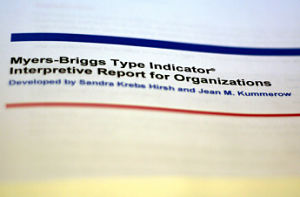 Public Policy
Public Policy Myers-Briggs at Work? Might Be a Terrible Idea (MBTI)

DO use this test to chart Harry Potter characters. DO NOT use this test to make decisions about employees.
The Myers-Briggs Type Indicator (MBTI) is the most popular personality test, boasting millions of test-takers each year. Developed in the 1940s by Isabel Briggs Myers and Katharine Briggs, the MBTI is based on the ideas of Carl Jung. Upon completion, test-takers are presented with one of 16 personality types based on four dichotomies: extraversion-introversion (E-I), sensing-intuition (S-N, because “I” was already taken), thinking-feeling (T-F), and judging-perceiving (J-P).
Despite its general popularity, however, the Myers Briggs test is met with seemingly unanimous revulsion among academics (who are probably just skeptical INTPs). We (the authors) like to see ourselves as open-minded ENFPs, but alas, we must own up to our I and T tendencies. While we don’t necessarily meet the MBTI with revulsion, we’re far from impressed. Further, as management scholars, we have reservations about promoting the use of the MBTI in the workplace.

This article by Jesse E. Olsen and Peter Gahan originally appeared at The Conversation, a Social Science Space partner site, under the title “Why using Myers-Briggs at work Might Be a Terrible Idea (MBTI)”
1. The MBTI to make any employment decision Is Definitely a Terrible Idea (IDTI).
Here, we are in full agreement with the test developers’ original intent. According to the Myers-Briggs Foundation:
It is unethical and in many cases illegal to require job applicants to take the Indicator if the results will be used to screen out applicants. The administrator should not counsel a person to, or away from, a particular career, personal relationship or activity based solely upon type information.
The MBTI is meant for developmental purposes, and the 16 types are meant only to emphasize uniqueness, rather than goodness or badness — a lot like a horoscope.
But importantly, research suggests that scores or personality types as measured by the MBTI do not relate to job performance. Employee selection tools should be chosen based on the degree to which they find good employees; the MBTI does not do this — a lot like palm reading or handwriting analysis.
Further, in using personality tests more generally, we have to understand that there are limitations to measuring self-reported personality even with the more reliable instruments, and that situational factors also play a very important role in determining our behavior.
2. Using the MBTI as a reliable measure of personality Is Probably a Terrible Idea (IPTI).
MBTI results are based on self-reported preferences, which are forced into categories or types. The more reliable tests of self-reported personality — like the Big Five — measure aspects of the personality on more of a continuum, rather than as types.
When we measure many human characteristics — like height, weight, intelligence, and many personality traits – we tend to find that most people fall fairly close to the average and very few people fall at the extremes, forming what is known as a bell curve or normal distribution. What would happen if we choose to represent intelligence as an arbitrary dichotomy – “sophisticated-simple” (“S-I”, because they clearly can’t both be represented by “S”) — rather than as a continuous IQ score? If the average person (who sits around the middle of the distribution, near the arbitrary dividing line) took an intelligence test twice, they’d have a good chance of falling into a different category each time.
Here lies one of the big problems with the MBTI and the reason many people find their type changes when they take it multiple times. Most of us are about average on at least one of the four dimensions, which means that we probably teeter on the edge between two (or more) types. Answer one of the questions differently, and you might fall into a different personality type. This happens about 50% of the time, according to some reports, which should further emphasize the importance of not using the MBTI to make any important decisions.
3. Using the MBTI as a development tool Might Be a Terrible Idea (MBTI).
Using the MBTI in training and development can provide for some fun times at work. People like typologies, and going through the MBTI assessment and feedback process can provide an opportunity for self- and/or mutual understanding.
You may have reasons for spending around $35 per person on an unreliable and invalid test to further self-understanding or think about your career. (We won’t judge; we’re Ps, not Js.) However, we submit that there are plenty of equally unreliable and invalid tests available online for free, or that you might make your own, and that they might even be more fun than the MBTI. Your $35 could instead be directed to satisfying the world’s growing demand for creative ice bucket challenge videos.
So, in sum, the MBTI unreliably, invalidly, and perhaps even inappropriately assigns four-letter labels to test-takers. Of course, if this sounds like your idea of fun, go for it, but we’ll take our $35 to the local pub, for measurably more fun as we assign our own four-letter label to the MBTI.![]()


















































































